Dexcom MCT2D Continuous Glucose Monitor
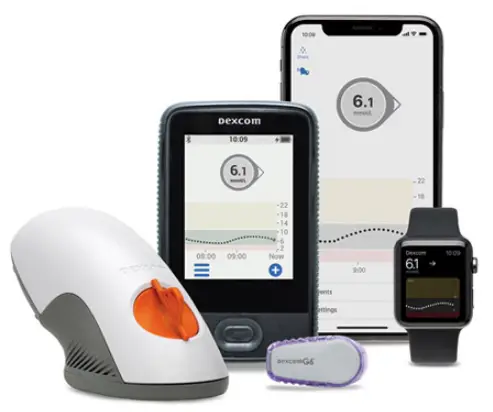
Specifications:
- Product Name: Dexcom Continuous Glucose Monitor (CGM)
- Developed in collaboration with Gary Scheiner, MS, CDCES
- Units for all glucose values are shown in mg/dL
Product Information:
The Dexcom Continuous Glucose Monitor (CGM) is designed to help users monitor their unique glucose patterns, understand how factors like physical activity and food affect glucose levels, and determine effective strategies for managing diabetes. It provides real-time data on glucose levels to assist users in making informed decisions about their health.
Product Usage Instructions
Getting Started
To begin using the Dexcom CGM:
- Insert the sensor according to the instructions provided.
- Pair the device with the receiver or compatible smartphone app.
- Calibrate the system as recommended by your healthcare provider.
Monitoring Glucose Levels
The Dexcom CGM continuously tracks glucose levels and displays real-time data on the receiver or smartphone app. Users can set target ranges and receive alerts for high or low glucose levels.
Analyzing Data
Review the data collected by the Dexcom CGM to identify trends, understand time spent in the target range, and make adjustments to diet, exercise, or medication based on the insights gained.
Setting Goals
Aim to increase time spent in the target glucose range (70-180 mg/dL) as recommended by healthcare professionals. Track progress over time and adjust lifestyle habits accordingly.
YOUR DEXCOM GUIDES
This playbook is designed to help you learn about your unique glucose patterns, how different factors like physical activity and food affect your glucose, and ways you can use your Dexcom Continuous Glucose Monitor (CGM) to discover what strategies work best for you. To guide you through this playbook, Joe and Joanne* share their stories about how they use Dexcom CGM to help them navigate their diabetes journeys. Joanne and Joe are cousins who live on opposite sides of the country. Joanne is married with two teenage daughters and works full-time managing a busy office. Joe is a retired electrician with six grandkids and loves his local sports teams. Joanne and Joe both have type 2 diabetes (T2D). Joe takes one injection daily of long-acting insulin along with a couple of oral medications. He tries to stay away from high-carb and fried foods, but like many people, he finds this hard to do. To stay active, he takes his grandkids to the park and pedals a stationary bike while watching his home sports teams on TV. Joanne manages her diabetes with an injected medication (not insulin) that helps with her appetite and an oral medication that can sometimes cause her glucose to go too low. She sticks with mostly low-carb foods and walks with a co-worker during their lunch breaks.
All characters in this book are fictional. Any similarity with actual people is completely coincidental. This book is not intended as medical advice, always consult your healthcare provider before making changes to your diabetes treatment plan. Units for all glucose values are shown in mg/dL.
A NEW JOURNEY WITH DIABETES
A few months ago, Joe and Joanne both started using something new and exciting: the Dexcom CGM system. They got together recently at a family event and discussed their experiences with Dexcom – what features they like and how they’ve used their Dexcom CGM to make changes with their food choices and physical activity to help manage their T2D. Here’s what they have to say:
 Hi! I’m Joanne. My cousin Joe and I are here to talk about a pretty cool technology called the Dexcom CGM. This type of technology is also referred to as “RT-CGM,” or real-time CGM, because it gives you your glucose values in real-time. But before we do, we want to share a few things. I’ve lived with type 2 diabetes for almost ten years, so I know what it’s like. Along with family and work, I have this chronic health condition to take care of 24/7, 365 days a year. I didn’t ask for it, and it’s not my fault I have it. When you have type 2 diabetes, you can’t just take a pill and make it go away. There’s a lot of work to do making healthy food choices, being physically active, reducing stress, taking our meds, and checking our glucose levels. It takes a lot of effort, but it really is worth it. I feel better when my diabetes is well-managed. I have more energy, I sleep better, and my mind is clearer. And it feels good knowing that I’m doing things to prevent long-term health problems.
Hi! I’m Joanne. My cousin Joe and I are here to talk about a pretty cool technology called the Dexcom CGM. This type of technology is also referred to as “RT-CGM,” or real-time CGM, because it gives you your glucose values in real-time. But before we do, we want to share a few things. I’ve lived with type 2 diabetes for almost ten years, so I know what it’s like. Along with family and work, I have this chronic health condition to take care of 24/7, 365 days a year. I didn’t ask for it, and it’s not my fault I have it. When you have type 2 diabetes, you can’t just take a pill and make it go away. There’s a lot of work to do making healthy food choices, being physically active, reducing stress, taking our meds, and checking our glucose levels. It takes a lot of effort, but it really is worth it. I feel better when my diabetes is well-managed. I have more energy, I sleep better, and my mind is clearer. And it feels good knowing that I’m doing things to prevent long-term health problems.
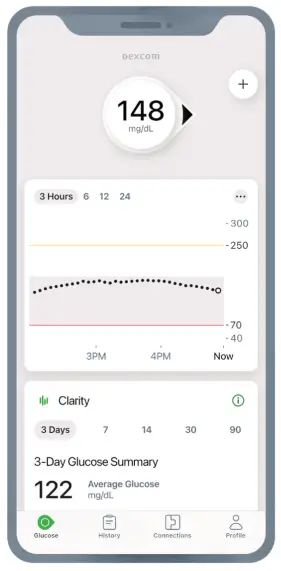
Joe, anything to add?
I think the real secret is to “own” your diabetes. People might try to tell you what you should and shouldn’t do, but everyone is different. I like to experiment with different things and see what works and what doesn’t. Joanne, remember that wedding we were at a few years ago? We both ate a lot. But you also did a lot of dancing, and your glucose was lower than mine at the end of the night. That taught me something. Knowledge really gives you power!
That’s one of the reasons I love my Dexcom CGM. I can see what makes my glucose go up and what keeps it in range. It even tells me when I’m starting to get too low so I can grab something to eat. When I go for my checkups, the doctor and nurse look at my Dexcom Clarity reports to see what’s really going on with my diabetes. They say it gives them more information than just looking at my AlC. Joe, you’re forgetting something very important. No fingersticks!* But that’s just the beginning of what Dexcom CGM has to offer. Making changes can be hard, but when you can see your glucose levels and trends in real-time, it helps you feel empowered to make healthy choices and continue to make them. I’m learning something new all the time. Let’s share some of the things we’ve learned so that EVERYONE can benefit.
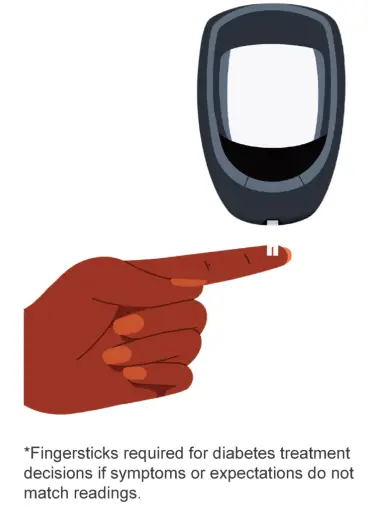
DID YOU KNOW?
Dexcom provides a free program called Clarity that helps users learn more about their glucose patterns. Healthcare professionals can also access the same reports in their clinics.
WHAT’S IN IT FOR ME?
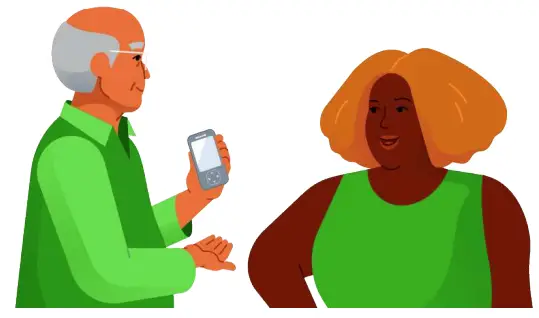 Joe, most people know that the A1C is a blood test that estimates the average glucose level for the past two to three months. But there are many things that can cause the A1C to be higher or lower than what you would expect – including race/ethnicity, anemia, pregnancy, blood transfusions & donations, and certain medications.1 Plus, the A1C is just an average – it does not tell us how stable the glucose levels have been.2 That’s for sure, Joanne. Since I’ve been using my Dexcom CGM, not only has my A1C gone down, but I’ve also had fewer highs and lows.3 Instead of waiting months to recheck my A1C, I can see the changes immediately on my Dexcom CGM to know what’s working and what’s not working so well. And one of the best parts, I feel much better! Take a look at the graph below. That time in the gray, between 70 and 180 mg/dL, that’s my target glucose range called Time in Range (TIR). When I’m in that range, I feel better. My energy is up, I can focus, I run to the bathroom less, and I wake up feeling more rested. So now I’m looking at more than just my A1C. Dexcom CGM shows me how much time I spend in my target glucose range.
Joe, most people know that the A1C is a blood test that estimates the average glucose level for the past two to three months. But there are many things that can cause the A1C to be higher or lower than what you would expect – including race/ethnicity, anemia, pregnancy, blood transfusions & donations, and certain medications.1 Plus, the A1C is just an average – it does not tell us how stable the glucose levels have been.2 That’s for sure, Joanne. Since I’ve been using my Dexcom CGM, not only has my A1C gone down, but I’ve also had fewer highs and lows.3 Instead of waiting months to recheck my A1C, I can see the changes immediately on my Dexcom CGM to know what’s working and what’s not working so well. And one of the best parts, I feel much better! Take a look at the graph below. That time in the gray, between 70 and 180 mg/dL, that’s my target glucose range called Time in Range (TIR). When I’m in that range, I feel better. My energy is up, I can focus, I run to the bathroom less, and I wake up feeling more rested. So now I’m looking at more than just my A1C. Dexcom CGM shows me how much time I spend in my target glucose range.
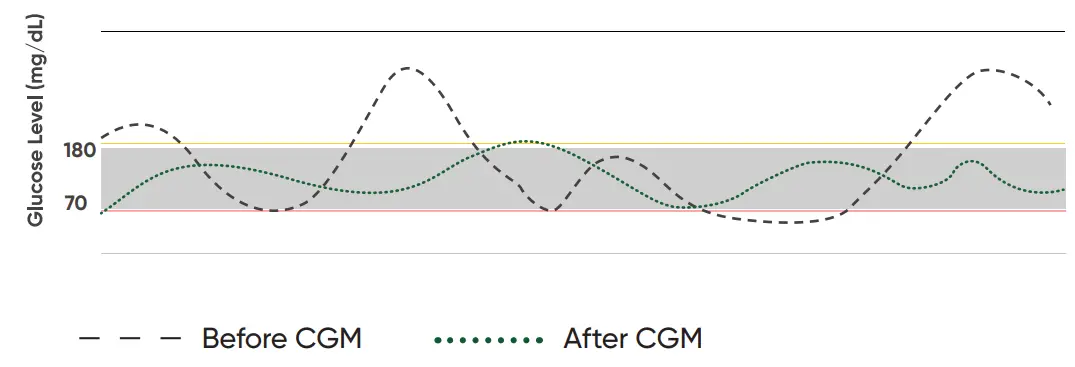
When I first started using Dexcom CGM, my TIR was less than 50%. I was spending almost 12 hours a day above 180! That’s when I started paying more attention to my food and activity and learning about my diabetes. Now I’m in range more than 80% of the time.4 That’s about 8 more hours a day feeling better than I did before! Because of this, I’ve been able to stop taking one of my diabetes medications. My doctor told me if I can continue this progress, she sees no reason why I would have to add it back.
GOALS FOR TIME IN RANGE
The International Consensus on Time in Range2 recommendations for most people with type 1 and type 2 diabetes:*2
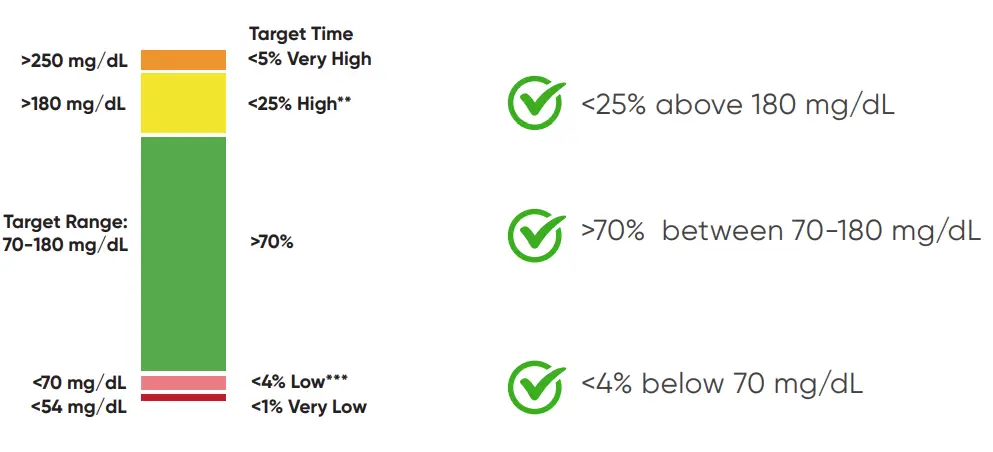
DID YOU KNOW?
A TIR of 70% is equal to an A1C of about 7%.2
Fast Fact: 1% of the day equals about 15 minutes. So, 4% of the day represents about an hour.2
- Recommendations from the International Consensus on Time in Range, 2019 recommend individualized glycemic targets for high-risk and/or older adults with a focus on reducing the percentage of time spent less than 70 md/dL and preventing excessive hyperglycemia.
- Includes percentage of values >250 mg/dL
- Includes percentage of values <54 mg/dL
TOP 5 TIPS FOR DIABETES MANAGEMENT USING DEXCOM RT-CGM
WATCH THE TREND ARROWS
I don’t know about you, Joe, but I don’t know how I managed without my Dexcom CGM. The first thing I noticed when I started using it was how helpful the trend arrows are. I realized that a glucose of 120 with two arrows up is very different from a glucose of 120 with a steady arrow. How is that, Joanne? Isn’t a 120 a 120?
WHAT DO THE TREND ARROWS MEAN?
For more information on trend arrows, see pages 30-31 in the User Guide. G7 User Guide
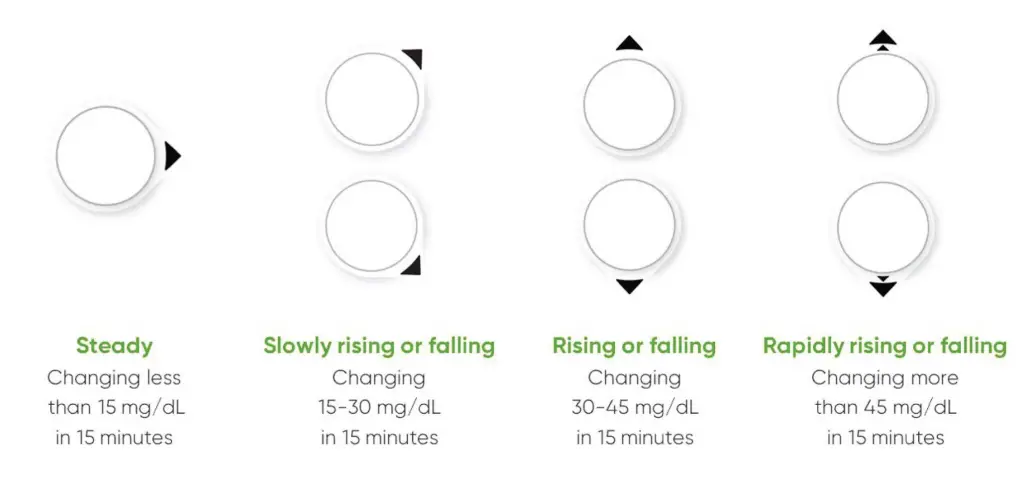
- Steady Changing less than 75 mg/dl in 15 minutes
- Slowly rising or falling Changing 75-30 mg/dl in 15 minutes
- Rising or falling Changing 30-45 mg/dl in 15 minutes
- Rapidly rising or falling Changing more than 45 mg/dl in 15 minutes
Good question, Joe! Glucose levels are constantly changing. Dexcom CGM lets us know where our glucose is headed, not just where it is at the time. That helps us to make smarter decisions about things like:
- When and what can I eat?
- Is it a good time to exercise?
- Is it safe to drive? When do I need to check my glucose again?
Oh, I get it. For example, if my glucose looks like this a few hours after lunch, I don’t need to worry because it’s trending back into my target range.
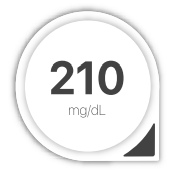
But if it looks like this, I could go for a quick walk to help lower my glucose. Or maybe I need to cut down on the carbs in my lunch next time.
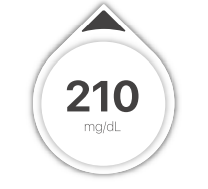
Trend arrows help us predict where our glucose will be soon and let us be proactive with how we manage it. We may want to ask ourselves questions about when and what our last meal was, if we’ve recently done physical activity, been under stress, or if we took our medication as prescribed. Again, I don’t know how I ever managed without them.
SET MEANINGFUL ALERTS
Alerts can notify you when your glucose goes outside your target range, goes too low or too high, is rapidly falling or rising, or will be low soon. This lets you take action to prevent glucose from going too low or too high.5
TO PREVENT LOW GLUCOSE
Consider setting the low alert a little higher than the level you want to stay above. Discuss with your healthcare team the best alert settings for you. Since I take insulin, there is a risk of hypoglycemia (low glucose). I hear that certain diabetes pills can also make the glucose level go too low. My body has trouble sensing when my glucose is heading low until it gets really low, and by then, I can’t think too clearly. So, I love the fact that my Dexcom CGM alerts me … not just when it’s low, but before it gets low. That way, I can take some juice or glucose tablets before I get into trouble or need help.
STEPS TO ADJUST LOW ALERT IN THE G7 APPt
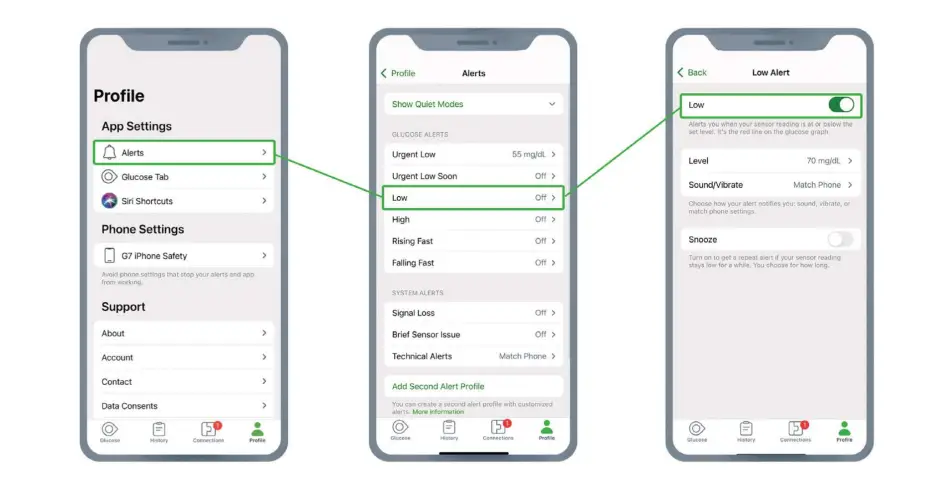
JOE’S BRIGHT IDEA
It is easy to overlook the alerts after a period of time. I like to change up the sound the alert makes every so often so that I’m more likely to notice it. This can be done easily in the Alert settings, under Low, Sound/Vibrate, Alert Sound.t
For me, the high alert is super helpful. Like most people, it’s not realistic to eat perfectly all the time. If I go higher than my target range, I’ve found that I can bring my glucose back down with a brisk walk or by doing some chores around the house. Great point, Joanne. One more thing that’s very important when it comes to the alerts is to respond to them quickly. With a low alert, it is critical to take some rapid-acting carbs right away. For high glucose, there is a new Delay 1st Alert feature that is actionable and helps reduce < Bad< High Alert bothersome high alerts right after I eat. This prevents getting an alert until my glucose has been high for a while and when it’s a better time to act. I get to choose how long to set the delay.
For example, if I set the Delay 1st Alert to two hours, my glucose must be at or above my high alert setting for two hours before I get the alert. You can set the Delay 1st Alert in your High Alert profile. Talk to your healthcare team about ways to optimize your alerts.
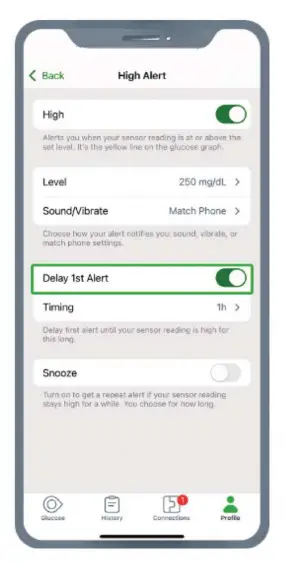
DISCOVER!
Whoever said that diabetes is boring must have never used a Dexcom CGM, because every day is like a science discovery. It’s not just about food and exercise – there are many factors that can affect glucose levels. Some are within our control, and some are not. I try to experiment with things that I have some control over. This morning, I decided to try something different for breakfast. Look at the change in my trend graphs between yesterday and today. With my usual bacon, eggs, and toast breakfast, my glucose hardly rose at all. But with cereal, look how high it went! You know, Joanne, if you only looked at your fasting glucose, you would have no idea of the difference your food choice makes. Dexcom CGM showed exactly what happened.Nowlknow to stick with my usual eggs in the morning.
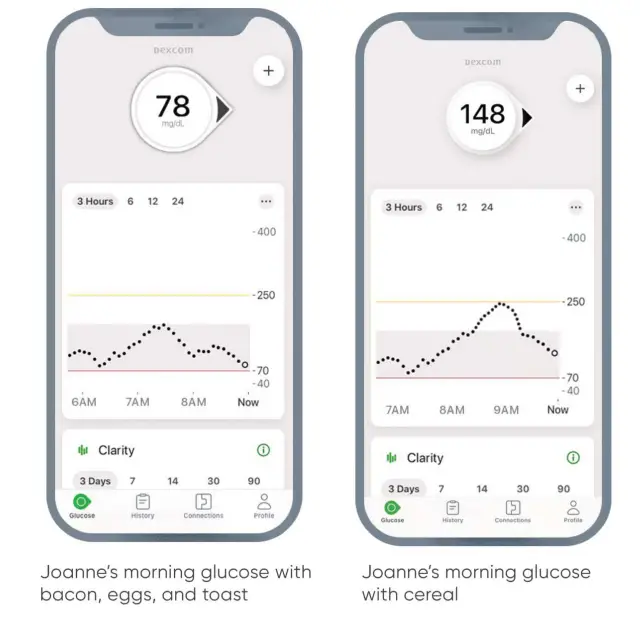
TECH TIP
When doing your own experiments, you can easily see on-screen trend graphs for time periods of 3, 6, 12 or 24 hours. On the Dexcom G7 opp, turn your phone sideways (into “landscape” mode) and tap on the number of hours you want to see at the top of the screen.
Great point, Joe! I’ve also learned that my glucose comes into target range faster if I go for a walk after a meal. We sometimes take the kids out for pasta. Here’s what happens to my glucose if I walk compared to sitting in front of the TV afterward.
Yea, Joanne, exercise can be pretty powerful. I’ve seen that. Sometimes I lift weights and sometimes I use an exercise bike, and each one affects my glucose differently. My Dexcom CGM shows a pretty quick drop when I’m on the bike, so I know I have to snack before. But my glucose holds pretty steady when I lift weights, so I don’t usually need a snack. I never expected that! Glad I’m looking at my Dexcom CGM.
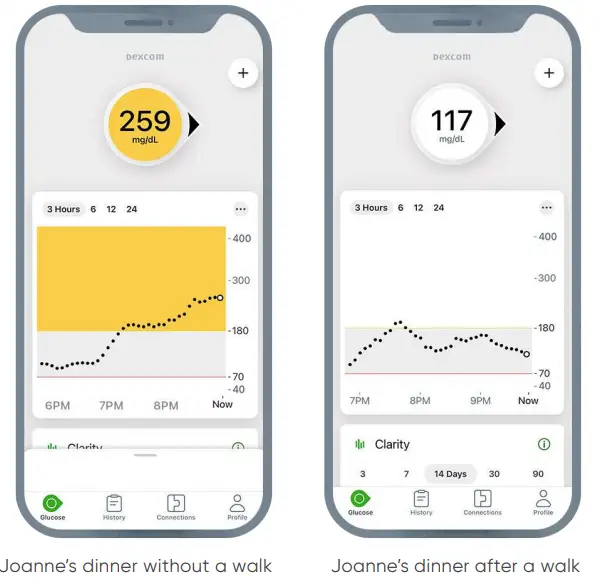
CONSIDER THIS
What you learn can help you spend more time in the grey zone (70-180 mg/dL) on the trend graph.
- See how different food types (carbs, proteins, fats) and portion sizes impact your glucose level
- Find out which of your favorite foods causes less of a glucose rise after you eat them
- Learn how different forms of physical activity affect your glucose
- See how exercising at different times of day affects your glucose
- Discover the impact of relaxation and stress-reduction
- Check to see how different sleep patterns affect your glucose levels
IT’S ALL ABOUT PATTERNS
Joe, I know you’re a big fan of the History Channel. So, let’s talk about “glucose history.” Dexcom has a program called Clarity that provides really useful information. You can review the Clarity reports on an opp on your smartphone or on a computer through the Clarity website.
Clarity makes it easy to learn about your glucose patterns and how small changes can make big impacts in your TIR. Even a 5% increase in TIR is significant!2 You can also opt into receiving a notificationt on the days you reach your time in range goal.
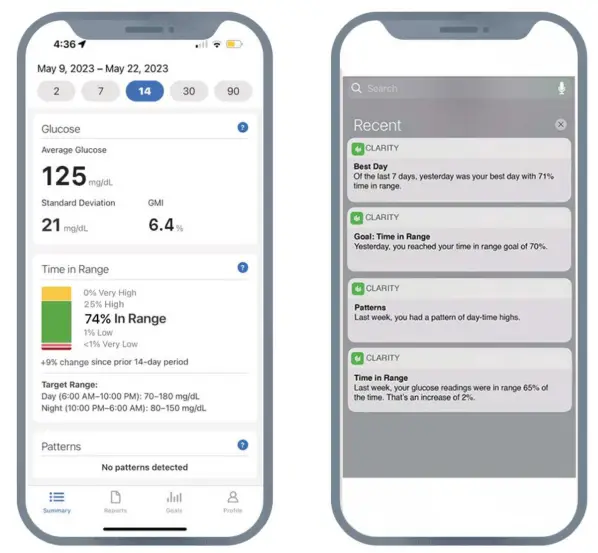
An easy way to opt into these notifications is through your Clarity opp. Go to your Profile > Notifications. You can then choose which notifications you’d like to receive. Research shows that more people who enable Dexcom Clarity notifications achieve time in range goals than those who do not. 6 One of my favorite notifications is the one that shows my Best Day of the week!
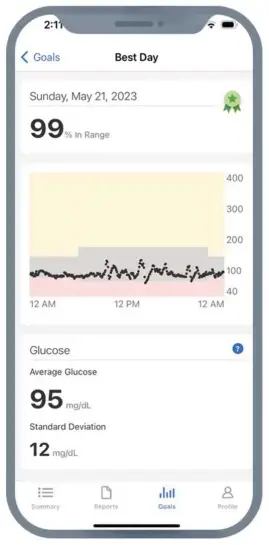
For information on how to use the Dexcom G7 Receiver, visit https://www.Dexcom.com/en-us/guides
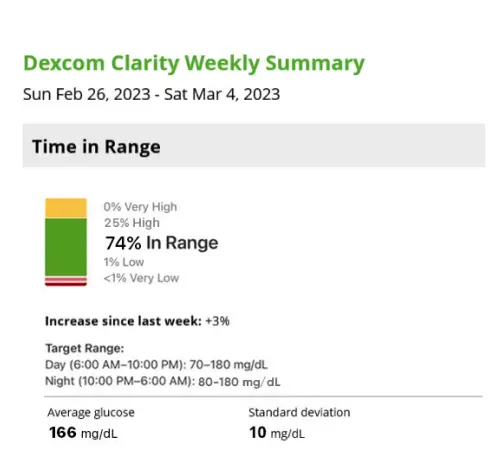
TECH TIP
Clarity can produce weekly notifications sent to your email or smart phone. These notifications show things like how much time you are spending in range, how much it’s changed from the previous week, and patterns that may be developing.‡
When I add notes into my Dexcom app I can look back and see what I did that day and try to do more of what’s working well for me. A report that my doctor asked me to look at is called the AGP report. AGP stands for “Ambulatory Glucose Profile.” It’s like a summary of a person’s glucose levels for a two-week period in the form of a picture. There are two solid lines going across the graph that represent the target glucose range, 70 mg/ dL to 180 mg/dL.
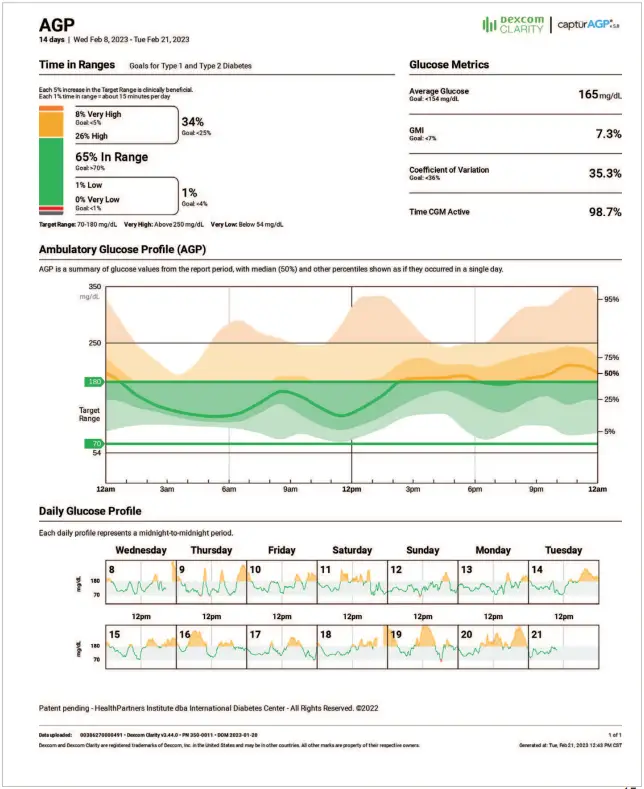

Here is what my AGP graph looked like soon after I started using the Dexcom CGM. The time of day runs from left to right: the far-left side shows my average glucose levels at midnight. The middle shows noontime, and the far right is midnight again. The solid squiggly line running through the middle of the graph shows my average glucose level at each phase of the day.
Here is my recent AGP graph. It wasn’t perfect, but I’m in range (in the green) a LOT more than I used to be. I also don’t have as many extreme highs in the afternoon/evening as I used to. I think that has a lot to do with my after-lunch walks and cutting down on all the afternoon snacks.
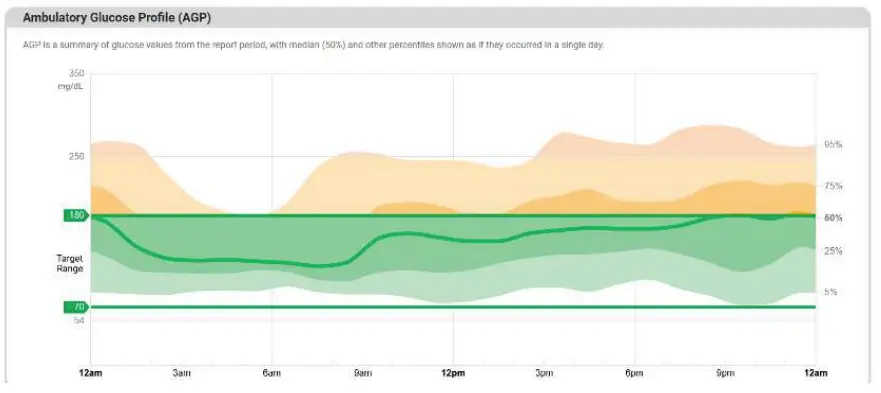
What do the shaded areas mean, Joanne?
The green shaded area shows when you are in your target range. Yellow is above your target range and red is below. The goal is to see lots of green and as little yellow and red as possible. It is also nice to see a fairly flat and narrow band going across the day – this means that the glucose levels are fairly consistent, without a lot of high highs and low lows.
JOE & JOANNE’S DEXCOM GRAB BAG: A FEW OF OUR FAVORITE THINGS
In this section, we’ll highlight some of our personal favorite features and additional strategies for getting the most out of Dexcom CGM.
URGENT LOW SOON ALERT
Urgent Low Soon is an alert feature that is automatically turned on in your Dexcom CGM. This alert “predicts” when your glucose is expected to reach 55 mg/dL within the next 20 minutes and provides an alert for you to take action ahead of time. Utilizing the Urgent Low Soon Alert is proven to help Dexcom users spend less time in hypoglycemia.7 I know it has helped me avoid a number of potential lows!
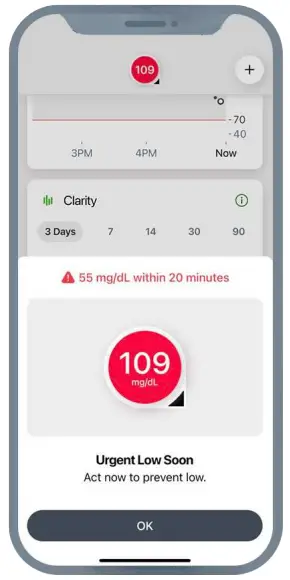
LOGGING EVENTS
Logging events can help you understand what caused your glucose to change. Log events regularly or when you want to learn about new foods, physical activity or when you experience something out of your normal routine. You can add events for insulin doses, meals (number of carbs consumed), activity, and blood glucose meter values into your G7 app. You can also take notes where you type something specific about an event (e.g., “ate half of my sandwich with chips and an apple” or “stressful drive into work”).
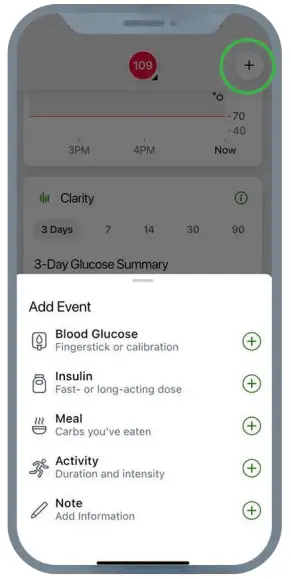
To add an event in your G7 opp, tap + in the Glucose or History tab and select the type of event you want to add.t When an event is entered into your display device it will appear in your Clarity reports for you and your healthcare team to view.
DEXCOM FOLLOW APPt §

Something that gives my loved ones and me more peace of mind is being able to share my real-time glucose values with my friends and family. Did you know there are ways to share your real-time Dexcom data? Research has shown that people who share their data with a loved one (let them see the glucose and receive alerts on their smartphones) tend to spend more time in their target glucose range, feel less alone with their diabetes, and sleep better.8·9 To start sharing, go to Connections in your Dexcom G7 opp, select Share, then Invite Follower. All you need is their email address. They will receive an email invitation to download the Dexcom Follow opp. By the way, you can choose exactly which information and alerts you want them to receive and change it at any time.

- For information on how to use the Dexcom G7 Receiver, visit https://www.dexcom.com/en-us/guides
- Separate Follow opp required. For compatibility, visit dexcom.com/compatibility
It’s also beneficial to share your data with your healthcare team. That way, they can quickly review your recent data during or between appointments as needed. They may be able to see patterns that require a change to your diabetes management plan. Viewing data together can help you and your healthcare team have more meaningful conversations.
SHARING IS CARING
You can provide your Dexcom data to your healthcare team when you are using the G7 opp or the receiver – without going into the office! Your healthcare team can generate a share code for you to accept and begin sharing your data.
- If using the G7 opp, a share code allows automatic sharing with your healthcare team.
- If using the G7 receiver, a share code enables your data to be shared each time you upload your receiver to a home computer. Or, your healthcare team can upload your receiver when you are in the office. Learn more in the Clarity Guide to Reports.
CLARITY METRICS
You can quickly see your glucose averages and changes over time directly in your G7 opp or receiver! Clarity metrics are available for the past 3, 7, 14, 30 and 90 days. If using the G7 opp, simply scroll to the bottom of the home screen. What is your 14-day average?
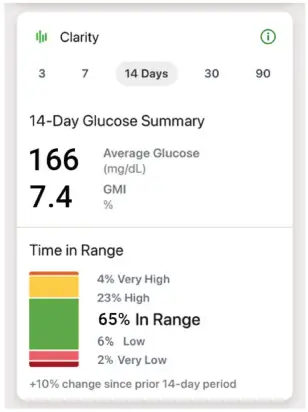
WRAPPING THINGS UP
There you have it! Joe and Joanne shared the top strategies they found helpful throughout their diabetes journeys. Now it’s your turn to explore with your Dexcom CGM and learn what works best for you!
- Go on a journey of personal discovery! Be curious, try different things and learn how your body responds in real time.
- Review your glucose history and learn from the patterns you find. Glucose values are not good or bad. They all provide helpful information for making smart choices and behavior changes.
- Use the features of your Dexcom CGM to see more green on the TIR bar and AGP reports.
- Acknowledge the hard work required to manage diabetes and celebrate your success!
HELPFUL PHONE NUMBERS:
- Dexcom CGM training and education support: 888-738-3646
- 24/7 Product Support: 844-607-8398
- Or use your Dexcom G7 app to complete a Product Support Request (in the Profile tab, scroll down to the Support section and select Contact)
HELPFUL WEBSITES:
- Online Dexcom Support and Education resources
- Learn tab of the Dexcom homepage for information about CGM, Dexcom G7 training, and Dexcom G6 training
- Brief Training videos for Dexcom G6 and G7 apps and receivers
- Dexcom Frequently Asked Questions
- Submit Product Support Request
Work with your healthcare team to figure out what’s best for you when making treatment decisions. Always use their instructions to manage your diabetes.
REFERENCES
- Radin MS. Pitfalls in hemoglobin A1c measurement: when results may be misleading. J Gen Intern Med. 2014;29(2):388-394. doi:10.1007/s11606-013-2595-x
- Battelino T, Danne T, Bergenstal RM, et al. Clinical Targets for Continuous Glucose Monitoring Data Interpretation: Recommendations From the International Consensus on Time in Range. Diabetes Care. 2019;42(8):1593-1603. doi:10.2337/dci19-0028
- Acciaroli G, Welsh JB, Akturk HK. Mitigation of Rebound Hyperglycemia With Real-Time Continuous Glucose Monitoring Data and Predictive Alerts. J Diabetes Sci Technol. 2022;16(3):677-682. doi:10.1177/1932296820982584
- Martens T, Beck RW, Bailey R, et al. Effect of Continuous Glucose Monitoring on Glycemic Control in Patients With Type 2 Diabetes Treated With Basal Insulin: A Randomized Clinical Trial. JAMA. 2021;325(22):2262-2272. doi:10.1001/jama.2021.7444
- Pettus J, Price DA, Edelman SV. HOW PATIENTS WITH TYPE 1 DIABETES TRANSLATE CONTINUOUS GLUCOSE MONITORING DATA INTO DIABETES MANAGEMENT DECISIONS. Endocr Pract. 2015;21(6):613- 620. doi:10.4158/EP14520.OR
- Akturk HK, Dowd R, Shankar K, Derdzinski M. Real-World Evidence and Glycemic Improvement Using Dexcom G6 Features. Diabetes Technol Ther. 2021;23(S1):S21-S26. doi:10.1089/dia.2020.0654
- Puhr S, Derdzinski M, Welsh JB, Parker AS, Walker T, Price DA. Real-World Hypoglycemia Avoidance with a Continuous Glucose Monitoring System’s Predictive Low Glucose Alert. Diabetes Technol Ther. 2019;21(4):155-158. doi:10.1089/dia.2018.0359
- Welsh JB, Derdzinski M, Parker AS, Puhr S, Jimenez A, Walker T. Real-Time Sharing and Following of Continuous Glucose Monitoring Data in Youth. Diabetes Ther. 2019;10(2):751-755. doi:10.1007/s13300-019-0571-0
- Polonsky WH, Fortmann AL. Impact of Real-Time Continuous Glucose Monitoring Data Sharing on Quality of Life and Health Outcomes in Adults with Type 1 Diabetes. Diabetes Technol Ther. 2021;23(3):195-202. doi:10.1089/dia.2020.0466
Brief Safety Statement: Failure to use the Dexcom G7 Continuous Glucose Monitoring System (G7) and its components according to the instructions for use provided with your device and available at https://www.dexcom. com/safety-information and to properly consider all indications, contraindications, warnings, precautions, and cautions in those instructions for use may result in you missing a severe hypoglycemia (low blood glucose) or hyperglycemia (high blood glucose) occurrence and/or making a treatment decision that may result in injury. If your glucose alerts and readings from the G7 do not match symptoms, use a blood glucose meter to make diabetes treatment decisions. Seek medical advice and attention when appropriate, including for any medical emergency.
ABOUT THE AUTHOR
This playbook was developed in collaboration with Gary Scheiner, MS, CDCES, Owner and Clinical Director, Integrated Diabetes Services. Gary is a Certified Diabetes Care and Education Specialist in private practice and author of “Think Like a Pancreas” and “Practical CGM.” He was named Diabetes Educator of the Year in 2014 and has lived a positive life with diabetes since 1985.
Dexcom, Dexcom Clarity, Dexcom Follow, Dexcom One, Dexcom Share, and Share are trademarks or registered trademarks in the U.S. and may be in other countries. LBL-1003949 Rev001
FAQ
Q: How often should I calibrate the Dexcom CGM?
A: Calibration frequency may vary for each user. Follow the recommendations provided by your healthcare provider for accurate calibration.
Q: Can I swim or shower with the Dexcom CGM sensor?
A: The Dexcom CGM sensor is water-resistant, allowing users to swim or shower with it. However, prolonged exposure to water may affect sensor accuracy.
Documents / Resources
 |
Dexcom MCT2D Continuous Glucose Monitor [pdf] User Guide MCT2D, MCT2D Continuous Glucose Monitor, Continuous Glucose Monitor, Glucose Monitor, Monitor |
